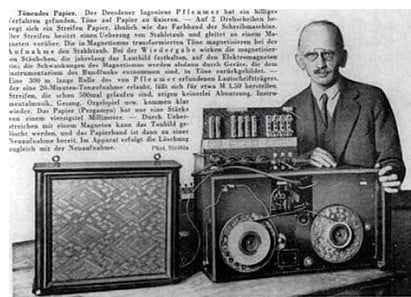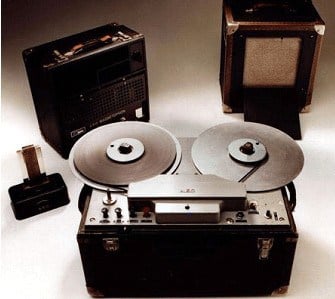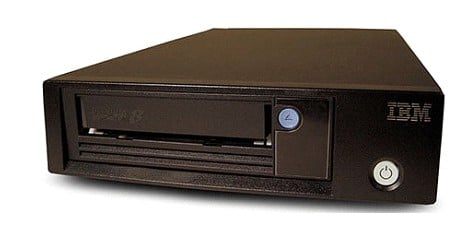4 Facts about Magnetic Tape
- Magnetic tapes were initially created for audio storage.
- The device is approximately 20% faster than other types of storage devices.
- Magnetic tapes were invented in Germany.
- Magnetic tapes originally had a small storage capacity.
Magnetic Tape History
The magnetic tape is the oldest memory media for computers, still in use today. Developed in Germany in 1928 but not used until 1951 in the Mauchly-Eckert UNIVAC I computer, the magnetic tape was created for audio storage and uses the magnetic wire recording principle.
In 1877 Oberlin Smith learned of the magnetic sound recording device (Phonograph) by Thomas Edison and decided to improve the Edison phonograph without initially getting away from a magnetic sound recording.
Quick Facts
- Created
- 1928
- Creator (person)
- Fritz Pfleumer
- Original Use
- For audio storage.
- Cost
- N/A
In 1878 Smith conceived an Electric Phonograph or Recording Telephone and drew up a “Caveat” (temporary patent) for the US Patent Office to a certain extent as a preliminary stage for a patent application on an Electric Phonograph or Recording Telephone, which deals exclusively with magnetic sound recording.
Oberlin had fabricated a cotton or silk thread, into which steel dust or short clippings of fine wire would be suspended. These particles were to be magnetized following the alternating current from a microphone source. Smith also discussed using a hard steel wire but thought it scarcely possible. It seems, however, that a working unit was never built. Smith’s ideas were further developed by The Danish engineer, Valdemar Poulsen (1869–1942).
In 1894, Poulsen discovered the magnetic recording principle while working as a mechanic in the Copenhagen Telegraph Company. In 1898 in his Telegraphone, he implemented for the first time the magnetic wire, and it was the first practical apparatus for magnetic sound recording and reproduction. In 1898 Poulsen obtained a patent in Denmark for his device and later did the same in other countries, see, for example, US patent 661619.
Magnetic wire recording, and its successor, magnetic tape recording, involves using a magnetizable medium that moves past a recording head. An electrical signal, which is analogous to the sound to be recorded, is fed to the recording head, inducing a pattern of magnetization similar to the signal. A playback head also referred to as the recording head, can then pick up the changes in the magnetic field from the tape and convert them into an electrical signal.
Poulsen later developed other magnetic recorders that recorded on a steel wire, tape, or disks. None of these devices had electronic amplification, but the recorded signal was easily strong enough to be heard through a headset or transmitted on telephone wires. At the 1900 World Exposition in Paris, Poulsen had the chance to record the voice of Emperor Franz Josef of Austria, today preserved in the Danish Museum of Science and Technology as the oldest magnetic sound recording in existence.
When Poulsen’s patent expired in 1918, Germany led efforts to improve magnetic recording. In the early 1920’s German inventor and entrepreneur, Dr. Curt Stille (1873-1957) from Berlin modified Poulsen’s Telegraphone to use electronic amplification and marketed the patent rights to the device, a wire recorder, to German and British companies.
In 1928, Stille formed the Echophone Co. and contracted with Ferdinand Schuchard AG and its talented young engineer Semi Joseph Begun (1905-1995) to manufacture the Dailygraph, the first cassette (magnetic wire) recorder. Semi Joseph Begun also developed the Stahltone-Bandmaschine steel 6 mm wide tape recorder in 1935. However, wire and steel tape was not a good solution and would be replaced in the 1930s by thin plastic tape, conceived by Fritz Pfleumer.
Dr. Fritz Pfleumer (20 March 1881, Salzburg, Austria – 29 August 1945, Radebeul, Germany) was a German-Austrian engineer. He graduated in engineering at the University of Dresden in 1902. Pfleumer had developed a process for putting metal stripes on cigarette papers and reasoned that he could similarly coat a magnetic stripe to be used as an alternative to wire recording.
In 1927, after experimenting with various materials, Pfleumer used very thin paper, which he coated with iron oxide powder using lacquer as glue. Pfleumer was granted in 1928 a patent in Germany for the application of magnetic powders to strips of paper or film.

In 1930 the AEG (Allgemeine Elektrizitatsgesellschaft) company in Berlin decided to develop the Magnetophone machine, based on the Pfleumer principle, and in 1932, Pfleumer granted the right of use to the AEG based on his invention. In the same 1932, AEG signed an agreement of collaboration with BASF, the company of Ludwigshafen: AEG developed the system, BASF an appropriate sound carrier. BASF had a rich experience and, in 1934, was able to ship the first 50000 meters of magnetic tape.
The tape consisted of a foil of cellulose acetate as carrier material, coated with a lacquer of iron oxide as a magnetic pigment, and cellulose acetate as a binder. During the 1935 Radio Fair in Berlin, the Magnetophone and the Magnetic Tape were presented to the public.

In 1936 the German National Court canceled Pfleumer’s patent because his idea of coating paper tape with iron dust was covered in Valdemar Poulsen’s original patents of 1898 and 1899, so Poulsen stands alone as the inventor of all magnetic recording.
The magnetic tape was not used to record data until 1950, when the UNISERVO I, the first digital tape recorder, was developed in Eckert-Mauchly Co. and was implemented in 1951 UNIVAC I computer architecture.
The tape devices and media technologies have come a long way since the 1950s. For example, the new IBM TS2280 Tape Drive, with its data transfer rate of up to 750 MBps (compared with 12.8 KBps for UNISERVO I) storage capacity up to 30.0 TB (184 KB for UNISERVO), etc.

Magnetic Tape: How It Worked
Magnetic tapes convert electrical audio signals into magnetic energy, thereby serving as the basis of their working principle. The conversion imprints such signals onto the tape; as the tape moves over magnetic heads, the magnetic particles cause the pulses to align into patterns, causing sound production.
The tape is moved at a consistent speed using a tape machine. If the speed changes due to any reason whatsoever, whether faulty motors or improper settings, it will distort the pitch.
Magnetic Tape: Historical Significance
The invention of magnetic tapes led to a major revolution in sound recording, broadcasting, and reproduction. Magnetic tapes were initially introduced for sound recording. Although initially created to record sound, the magnetic tape now offers numerous uses, including allowing users to record gramophone records in multiple parts, radio, TV, etc.
However, they have grown scarce thanks to the rapidly increasing emergence of audiovisual media storage and digital imaging today to suit the ever-advancing computer architecture. Nowadays, other technologies such as SSD drives are gradually replacing magnetic tapes.
Interestingly, regardless of these advancing technologies, companies types like IBM and Sony haven’t stopped producing new magnetic tapes for commercial sales.
